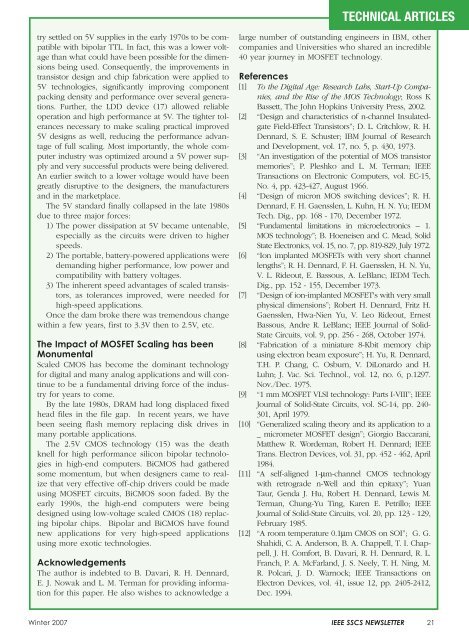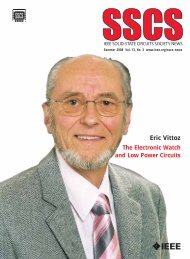The Impact of Dennard's Scaling Theory - IEEE
The Impact of Dennard's Scaling Theory - IEEE
The Impact of Dennard's Scaling Theory - IEEE
- TAGS
- scaling
- www.ieee.org
Create successful ePaper yourself
Turn your PDF publications into a flip-book with our unique Google optimized e-Paper software.
try settled on 5V supplies in the early 1970s to be compatible<br />
with bipolar TTL. In fact, this was a lower voltage<br />
than what could have been possible for the dimensions<br />
being used. Consequently, the improvements in<br />
transistor design and chip fabrication were applied to<br />
5V technologies, significantly improving component<br />
packing density and performance over several generations.<br />
Further, the LDD device (17) allowed reliable<br />
operation and high performance at 5V. <strong>The</strong> tighter tolerances<br />
necessary to make scaling practical improved<br />
5V designs as well, reducing the performance advantage<br />
<strong>of</strong> full scaling. Most importantly, the whole computer<br />
industry was optimized around a 5V power supply<br />
and very successful products were being delivered.<br />
An earlier switch to a lower voltage would have been<br />
greatly disruptive to the designers, the manufacturers<br />
and in the marketplace.<br />
<strong>The</strong> 5V standard finally collapsed in the late 1980s<br />
due to three major forces:<br />
1) <strong>The</strong> power dissipation at 5V became untenable,<br />
especially as the circuits were driven to higher<br />
speeds.<br />
2) <strong>The</strong> portable, battery-powered applications were<br />
demanding higher performance, low power and<br />
compatibility with battery voltages.<br />
3) <strong>The</strong> inherent speed advantages <strong>of</strong> scaled transistors,<br />
as tolerances improved, were needed for<br />
high-speed applications.<br />
Once the dam broke there was tremendous change<br />
within a few years, first to 3.3V then to 2.5V, etc.<br />
<strong>The</strong> <strong>Impact</strong> <strong>of</strong> MOSFET <strong>Scaling</strong> has been<br />
Monumental<br />
Scaled CMOS has become the dominant technology<br />
for digital and many analog applications and will continue<br />
to be a fundamental driving force <strong>of</strong> the industry<br />
for years to come.<br />
By the late 1980s, DRAM had long displaced fixed<br />
head files in the file gap. In recent years, we have<br />
been seeing flash memory replacing disk drives in<br />
many portable applications.<br />
<strong>The</strong> 2.5V CMOS technology (15) was the death<br />
knell for high performance silicon bipolar technologies<br />
in high-end computers. BiCMOS had gathered<br />
some momentum, but when designers came to realize<br />
that very effective <strong>of</strong>f-chip drivers could be made<br />
using MOSFET circuits, BiCMOS soon faded. By the<br />
early 1990s, the high-end computers were being<br />
designed using low-voltage scaled CMOS (18) replacing<br />
bipolar chips. Bipolar and BiCMOS have found<br />
new applications for very high-speed applications<br />
using more exotic technologies.<br />
Acknowledgements<br />
<strong>The</strong> author is indebted to B. Davari, R. H. Dennard,<br />
E. J. Nowak and L. M. Terman for providing information<br />
for this paper. He also wishes to acknowledge a<br />
TECHNICAL ARTICLES<br />
large number <strong>of</strong> outstanding engineers in IBM, other<br />
companies and Universities who shared an incredible<br />
40 year journey in MOSFET technology.<br />
References<br />
[1] To the Digital Age: Research Labs, Start-Up Companies,<br />
and the Rise <strong>of</strong> the MOS Technology; Ross K<br />
Bassett, <strong>The</strong> John Hopkins University Press, 2002.<br />
[2] “Design and characteristics <strong>of</strong> n-channel Insulatedgate<br />
Field-Effect Transistors”; D. L. Critchlow, R. H.<br />
Dennard, S. E. Schuster; IBM Journal <strong>of</strong> Research<br />
and Development, vol. 17, no. 5, p. 430, 1973.<br />
[3] “An investigation <strong>of</strong> the potential <strong>of</strong> MOS transistor<br />
memories”; P. Pleshko and L. M. Terman; <strong>IEEE</strong><br />
Transactions on Electronic Computers, vol. EC-15,<br />
No. 4, pp. 423-427, August 1966.<br />
[4] “Design <strong>of</strong> micron MOS switching devices”; R. H.<br />
Dennard, F. H. Gaensslen, L. Kuhn, H. N. Yu; IEDM<br />
Tech. Dig., pp. 168 - 170, December 1972.<br />
[5] “Fundamental limitations in microelectronics – 1.<br />
MOS technology”; B. Hoeneisen and C. Mead, Solid<br />
State Electronics, vol. 15, no. 7, pp. 819-829, July 1972.<br />
[6] “Ion implanted MOSFETs with very short channel<br />
lengths”; R. H. Dennard, F. H. Gaensslen, H. N. Yu,<br />
V. L. Rideout, E. Bassous, A. LeBlanc; IEDM Tech.<br />
Dig., pp. 152 - 155, December 1973.<br />
[7] “Design <strong>of</strong> ion-implanted MOSFET's with very small<br />
physical dimensions”; Robert H. Dennard, Fritz H.<br />
Gaensslen, Hwa-Nien Yu, V. Leo Rideout, Ernest<br />
Bassous, Andre R. LeBlanc; <strong>IEEE</strong> Journal <strong>of</strong> Solid-<br />
State Circuits, vol. 9, pp. 256 - 268, October 1974.<br />
[8] “Fabrication <strong>of</strong> a miniature 8-Kbit memory chip<br />
using electron beam exposure”; H. Yu, R. Dennard,<br />
T.H. P. Chang, C. Osburn, V. DiLonardo and H.<br />
Luhn; J. Vac. Sci. Technol., vol. 12, no. 6, p.1297.<br />
Nov./Dec. 1975.<br />
[9] “1 mm MOSFET VLSI technology: Parts I-VIII”; <strong>IEEE</strong><br />
Journal <strong>of</strong> Solid-State Circuits, vol. SC-14, pp. 240-<br />
301, April 1979.<br />
[10] “Generalized scaling theory and its application to a<br />
_ micrometer MOSFET design”; Giorgio Baccarani,<br />
Matthew R. Wordeman, Robert H. Dennard; <strong>IEEE</strong><br />
Trans. Electron Devices, vol. 31, pp. 452 - 462, April<br />
1984.<br />
[11] “A self-aligned 1-μm-channel CMOS technology<br />
with retrograde n-Well and thin epitaxy”; Yuan<br />
Taur, Genda J. Hu, Robert H. Dennard, Lewis M.<br />
Terman, Chung-Yu Ting, Karen E. Petrillo; <strong>IEEE</strong><br />
Journal <strong>of</strong> Solid-State Circuits, vol. 20, pp. 123 - 129,<br />
February 1985.<br />
[12] “A room temperature 0.1μm CMOS on SOI”; G. G.<br />
Shahidi, C. A. Anderson, B. A. Chappell, T. I. Chappell,<br />
J. H. Comfort, B. Davari, R. H. Dennard, R. L.<br />
Franch, P. A. McFarland, J. S. Neely, T. H. Ning, M.<br />
R. Polcari, J. D. Warnock; <strong>IEEE</strong> Transactions on<br />
Electron Devices, vol. 41, issue 12, pp. 2405-2412,<br />
Dec. 1994.<br />
Winter 2007 <strong>IEEE</strong> SSCS NEWSLETTER 21




